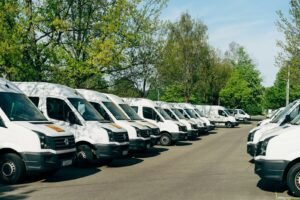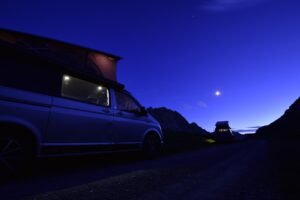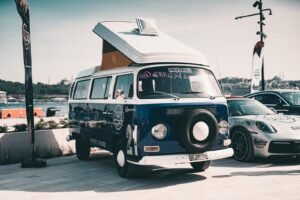If I could go back and redo my van build from scratch, I wouldn’t change everything — but I’d definitely rethink a few decisions that ended up being a waste of time, money, or effort.
These aren’t just regrets… they’re lessons. And if you’re just starting your build (or planning your second one), hopefully they’ll help you skip some of the trial-and-error.
1. Using Butyl Tape for Roof Seals
This stuff is everywhere in van build videos — but in my experience?
Butyl tape is the number one cause of leaks in climates with freeze–thaw cycles.
It doesn’t bond well to metal, it shifts, it shrinks, and it breaks down way faster than people think — especially in Canada or anywhere with hot days and cold nights.
What I’d do instead:
Skip the butyl and go straight to Sikaflex, Dicor Lap Sealant, or 3M Marine sealant. Use high-temp silicone around any exhausts.
Seal it once, seal it right.
2. Installing a Roof Rack for Solar
On paper, it made sense: use a roof rack to mount my flexible solar panel and still have space up top for other gear.
In reality? Total overkill.
- It added weight
- Made me look less stealth
- Created wind drag
- And didn’t help with solar production at all
If you’re using flexible solar, there’s no need for a rack. Just mount it flush to the roof using metal strips or adhesive and use a wind deflector to keep air from getting underneath.
3. Getting a Solar Panel at All (Seriously)
Here’s the unpopular truth:
Most vanlife solar setups don’t generate enough power to justify the cost or effort.
My panel barely produced anything, especially in winter or cloudy conditions.
Meanwhile, I was recharging my battery in under an hour at cafés or the gym — way more convenient, reliable, and consistent.
What I’d do instead:
- Ditch the solar
- Use shore power charging (gym, café, client’s house, etc.)
- And invest in a small gas generator if I ever needed serious off-grid power
That setup is way more flexible — and cheaper.
4. Using Pink Insulation (And Insulating at All)
I went with standard pink fiberglass insulation because it was cheap and easy to find.
But it turns out, it’s not ideal for van builds:
- It can hold moisture if there’s a leak
- It doesn’t handle vibration well
- And in the end… insulation inside a metal box doesn’t make that much of a difference
Between the cold metal, the windows, and all the air gaps, you’re never going to achieve perfect insulation — and honestly, with a diesel heater running, I’ve stayed comfortable without needing it.
What I’d do now:
- Skip the insulation entirely
- Or if I really wanted it, go with Rockwool
- But honestly? I’d focus more on ventilation and heat control than stuffing walls
5. Using Rivnuts in Factory Holes
I thought I was being smart by using pre-drilled factory holes in the van — no new holes, right?
Big mistake.
Some of the rivnuts came loose and just spun, making them useless.
I had to tear apart finished walls just to fix them.
What I’d do instead:
Just drill straight into the body when needed. It’s easier, more reliable, and not as scary as it seems.
Bonus: Things I Don’t Regret (And Would Absolutely Do Again)
Not everything was a mistake. Here are a few choices that ended up being total wins:
Installing Two Roof Vents
This was one of the best moves I made.
One vent pulls air in, the other pushes air out — makes a huge difference for airflow, condensation, and cooking.
Using a Diesel Heater
Super dry heat, barely uses power, and totally safe when installed right.
Compared to propane, it’s a night and day difference in comfort and efficiency.
Keeping the Water System Simple
I used a foot pump and gravity-fed setup — no 12V pump, no plumbing stress.
It helped me conserve water, stay low-tech, and avoid breakdowns.
Using Portable Power Stations Instead of a Wired Setup
I went with Bluetti-style power stations over a full marine battery + inverter setup.
They’re compact, safe, portable, and everything’s built-in — no need to wire anything. Plus, I can carry them into cafés or workspaces if needed.
Final Thoughts
These aren’t regrets — they’re just realizations that come with time on the road.
Some things sound good during the planning phase… but once you’re actually living in the van, simplicity wins every time.
If you’re starting your build now, keep it light, keep it functional, and don’t overcomplicate it. You can always add more later.
➡️ [Next read: “Essential Tools and Supplies for Living the Vanlife”]
➡️ [Next read: “Are Chinese Diesel Heaters Worth It? Here’s What You Need to Know”]
➡️ [Next read: “Best Free Places to Park Your Camper Van (Day + Night)”]





